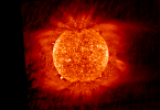HeCor et HEIT

The Sun and its corona as seen by HECOR and HEIT: preliminary results.
Launched on September 14, 2009 from White Sands Missile Range (New Mexico), the Herschel sounding rocket was carrying two experiments with strong IAS participation: HECOR and HEIT.
The HEIT images provide the intensity distribution on the solar disk at the time of flight, which is necessary to analyze the HECOR data. The HECOR image is the best ever obtained of the solar corona in the 30.4 nm resonance line of singly ionized Helium. A preliminary analysis suggests that the ‘horn-shaped’ structures are caused by local variations of the Helium abundance in the corona, at the edge of structures called ‘streamers’.
The determination of the Helium abundance in the corona was one of the main scientific objectives of HECOR. In order to confirm the presence of local variations of the abundance, a modeling of the formation process of the observed line in the physical conditions of the day of flight is necessary and was initiated by the team. The scientific results from HECOR are therefore expected in the coming months.
HEIT is a spare model of the EUI telescopes of the STEREO probes. IAS and IO have fabricated their EUV optics. HECOR was entirely designed by IAS and IO has provided the coatings. The design, fabrication, tests and delivery were completed in one and a half year. It’s the first coronagraph built by IAS. HECOR helped pave the way for future space missions using this type of instrument by capitalization of optical and mechanical know-how.
Contact: F. Auchère



